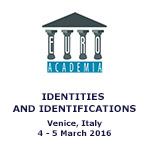Euroacademia Conferences
 Europe Inside-Out: Europe and Europeanness Exposed to Plural Observers (9th Edition) April 24 - 25, 2020
Europe Inside-Out: Europe and Europeanness Exposed to Plural Observers (9th Edition) April 24 - 25, 2020 Identities and Identifications: Politicized Uses of Collective Identities (9th Edition) June 12 - 13, 2020
Identities and Identifications: Politicized Uses of Collective Identities (9th Edition) June 12 - 13, 2020 8th Forum of Critical Studies: Asking Big Questions Again January 24 - 25, 2020
8th Forum of Critical Studies: Asking Big Questions Again January 24 - 25, 2020 Re-Inventing Eastern Europe (7th Edition) December 13 - 14, 2019
Re-Inventing Eastern Europe (7th Edition) December 13 - 14, 2019 The European Union and the Politicization of Europe (8th Edition) October 25 - 26, 2019
The European Union and the Politicization of Europe (8th Edition) October 25 - 26, 2019 Identities and Identifications: Politicized Uses of Collective Identities (8th Edition) June 28 - 29, 2019
Identities and Identifications: Politicized Uses of Collective Identities (8th Edition) June 28 - 29, 2019 The European Union and the Politicization of Europe (7th Edition) January 25 - 26, 2019
The European Union and the Politicization of Europe (7th Edition) January 25 - 26, 2019 7th Forum of Critical Studies: Asking Big Questions Again November 23 - 24, 2018
7th Forum of Critical Studies: Asking Big Questions Again November 23 - 24, 2018 Europe Inside-Out: Europe and Europeanness Exposed to Plural Observers (8th Edition) September 28 - 30, 2018
Europe Inside-Out: Europe and Europeanness Exposed to Plural Observers (8th Edition) September 28 - 30, 2018 Identities and Identifications: Politicized Uses of Collective Identities (7th Edition) June 14 - 15, 2018
Identities and Identifications: Politicized Uses of Collective Identities (7th Edition) June 14 - 15, 2018
What Is the Shape of this Problem?
-
-

-
Presentation speakers
- Ana Lucia Beck, King’s College London, UK / Universidade Federal do Rio Grande do Sul, Brazil
Abstract:
“What is the shape of this problem” is a verbal questioning present in the opening page of a series of 9 letterpress diptychs, which conjugate images and text, elaborated by Louise Bourgeois (France/EUA, 1911-2010). The question addresses two important issues regarding identity and identification within artistic production. On the one hand, it suggests a questioning about the identity of verbal and visual discourses in Art. But, on the other, it addresses Bourgeois’ reflection on her own creative process and its entanglement with her personal history. Like Brazilian artist Jose Leonilson (1957-1993), whose oeuvre also closely relates its contents and compositional efforts to personal and emotional history, Bourgeois’ questioning about the shape of her creative process recalls Webb’s perspective on W.B. Yeats’ poetry. According to Webb (2000), the poet’s oeuvre has to be considered taking into account the distinctive notions of “self-expression” and “poetic identity”. But, if self-expression and poetic identity are different matters, how do artists whose productions have close bonds with their own history, emotions and feelings proceed in order to reach poetic identity? Furthermore, taking into consideration Octavio Paz’s (2012) distinction between “poetic operation” and “technical manipulation”, how could these terms relate to Webb’s distinction and be taken into account comparatively in an analysis of Leonilson’s and Bourgeois’ production? Do these terms help or complicate the task of understanding these artists’ rhetoric in relation to their creative procedures? How do Leonilson and Bourgeois relate to stone, paper, words, colours, cloths of fabrics, drawing and stitching, taking actions that address their personal history and yet configure poetic operations and poetic identity? And is it possible to think that when an artist’s interrogation about the shape of such problems might also present us with something valuable for each one of us to ask ourselves about our own identities?
-
Related Presentations

How to Be or Not to Be an Iraqi Kurd? Processes of Identity Consolidation beyond National and Ethnic Rhetoric in the Autonomous Region of Kurdistan in Northern Iraq
- Silvia-Lucretia Nicola













